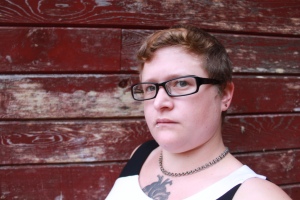 Kayla Whaley has a BA in political science and is currently finishing her Master’s in Public Administration with an emphasis in nonprofit management. She interns for both the Atlanta Young Writer’s Institute and Entangled Publishing. Her bookshelves consist almost entirely of kidlit and she writes YA fantasy and contemporary.
Kayla Whaley has a BA in political science and is currently finishing her Master’s in Public Administration with an emphasis in nonprofit management. She interns for both the Atlanta Young Writer’s Institute and Entangled Publishing. Her bookshelves consist almost entirely of kidlit and she writes YA fantasy and contemporary.
She’s previously written about her disability at DiversifYA.
The “disabled sibling” trope is arguably one of the most common disability tropes and definitely one of my least favorites (not that I have any favorites). You could certainly write a respectful, awesome story where the main character’s sibling has a disability, but this trope isn’t that.
The trope tends to involve a healthy dose of inspiration porn mixed with an even healthier dose of dehumanization. In my experience, the disabled sibling exists purely to make the main character’s life more “difficult,” more “sympathetic.” Oh, that poor dear, the writers want you to think, having to deal with such a horrible thing. It must be so hard.
The sibling with the disability is a source of frustration, anger, sadness, and general tragedy for their able-bodied sibling. It is not their story. They are not characters – they are props.
None of this is to say that having a sibling with a disability can’t be difficult or sad or whatever for the rest of the family. But it’s certainly not ONLY that, and in my case, it was RARELY that.
Growing up, I didn’t have very many doctors’ appointments (about one check-up a year), we didn’t have any medical bills thanks to our excellent insurance, my little sister was never expected to help take care of me, I wasn’t hospitalized but once for six days after my one surgery in fourth grade. As a family, we sacrificed little because of my disability. Sure, my parents acted as my primary caregivers until I went to college, and I’d occasionally feel badly if I needed to call for one of them more times than usual in the night to roll over or go to the bathroom. Vacations were a little trickier than they would’ve been otherwise, but not much.
I obviously can’t speak to how my family felt, but I very rarely felt like a burden on anyone, and certainly not to the extent I saw on TV and in books.
Of course, my sister and I had our difficulties, but they rarely had anything to do with my chair. I was always jealous of her artistic abilities; she was jealous of my grades. I was really religious; she was really not. I liked following rules, meeting expectations; she liked “rebelling”, finding her own path. I thought she got the most attention from our parents because she was the baby; she thought I got more because I was the “good kid”. In reality, I think we both knew we were equally loved.
And see how none of that was because of my disability? It wasn’t an issue. (Of course, maybe my sister felt differently as I can’t speak for her, but we’ve spoken about it before, so I feel pretty confident.)
So I couldn’t help feeling frustrated seeing those “disabled siblings”. It reflected nothing of my experience or of my family’s experience. Of course it offended me to see characters with disabilities relegated to those roles, but it also upset me to think that’s how people assumed my sister felt about me. That people assumed we weren’t close, that we didn’t love each other and learn from each other and admire each other. That we didn’t fight (boy, did we fight). That we didn’t do things like spend all afternoon lathering ourselves in Bath and Body Works glittery lotions.
That we weren’t sisters first, above all.
According to so many shows, books, and movies, my sister must have resented me. She must have fought to see the good in me and ultimately have learned to love me despite how horrible my disability made her life. Nay, learned to be inspired by all that I’ve overcome.
Fuck that noise.
I love my sister and she loves me and we always have and always will. Do we fight? God, yes. Do we get mad and jealous and spiteful? Absolutely. Do we dance and laugh and tease? Yup. Does she steal my stuff? Mmhmm. Do I think her boyfriends aren’t good enough for her? Sometimes. Is there anything, anything, I wouldn’t do for her? Not a thing. Am I sure she would say the same? Yes.
In short, we’re sisters.
And I think it’s a shame when stories ignore all the incredible, complex facets of any sibling relationship. It dehumanizes ALL your characters, both the disabled and able-bodied siblings. It’s disgusting and a waste and lazy.
Be better than that, writers. Be better for your characters, for yourself, and for all the disabled and able-bodied siblings who deserve to see themselves and their relationships in the stories they read.

 Alex Bear is an editorial intern at
Alex Bear is an editorial intern at  Cristina Hartmann is a writer (also publishes sci-fi works under the pen name Victoria Halley) who likes to jump out of planes and read books (not at the same time). Cristina has a weakness for YA books featuring female protagonists who can wield a sword like nobody’s business. When she’s not writing, jumping out of planes, or reading, Cristina loves cooking, eating, and playing with fuzzy creatures. (Alas, she’s not a fish person.)
Cristina Hartmann is a writer (also publishes sci-fi works under the pen name Victoria Halley) who likes to jump out of planes and read books (not at the same time). Cristina has a weakness for YA books featuring female protagonists who can wield a sword like nobody’s business. When she’s not writing, jumping out of planes, or reading, Cristina loves cooking, eating, and playing with fuzzy creatures. (Alas, she’s not a fish person.)
 Bethanie Borst is a 13-year-old with ADD and ASD. She writes twisted middle-grade fairy tales with her mom, Amie. Their first book, Cinderskella, releases October 2013! Bethanie can be found at
Bethanie Borst is a 13-year-old with ADD and ASD. She writes twisted middle-grade fairy tales with her mom, Amie. Their first book, Cinderskella, releases October 2013! Bethanie can be found at  Tracey Carter is a Library Associate II in Teen Services with Frederick County Public Libraries and is earning an MLIS from Florida State University. Lots of things make her nervous. To keep from worrying too much about everything Tracey likes to spend her free time reading YA books, playing video games, knitting, and keeping up with new technology trends. The best book she’s read so far this year is a three way tie between Eleanor & Park by Rainbow Rowell, Etiquette & Espionage by Gail Carriger, and Will & Whit by Laura Lee Gulledge. If you put an ampersand in your book title instead of the word “and” Tracey would appreciate it.
Tracey Carter is a Library Associate II in Teen Services with Frederick County Public Libraries and is earning an MLIS from Florida State University. Lots of things make her nervous. To keep from worrying too much about everything Tracey likes to spend her free time reading YA books, playing video games, knitting, and keeping up with new technology trends. The best book she’s read so far this year is a three way tie between Eleanor & Park by Rainbow Rowell, Etiquette & Espionage by Gail Carriger, and Will & Whit by Laura Lee Gulledge. If you put an ampersand in your book title instead of the word “and” Tracey would appreciate it.
 Writer, actor and occasional print model. Trained in the fine art of Lying Creative Truths, studied at the Institution of Making Things Up, and holds a Bachelor’s Degree in the field of Convincing People to Give Him Money in Exchange for the Performance of Ridiculous Labors. Significant moments in his career training have involved falling out of windows, driving other people’s expensive cars without crashing or obeying traffic laws, and kissing pretty boys and girls because the nice man in the director’s chair assured him it was a legitimate acting gig. His last recorded full night’s sleep was in the late nineties, and he would really appreciate it if you’d pass him some more coffee.
Writer, actor and occasional print model. Trained in the fine art of Lying Creative Truths, studied at the Institution of Making Things Up, and holds a Bachelor’s Degree in the field of Convincing People to Give Him Money in Exchange for the Performance of Ridiculous Labors. Significant moments in his career training have involved falling out of windows, driving other people’s expensive cars without crashing or obeying traffic laws, and kissing pretty boys and girls because the nice man in the director’s chair assured him it was a legitimate acting gig. His last recorded full night’s sleep was in the late nineties, and he would really appreciate it if you’d pass him some more coffee. 